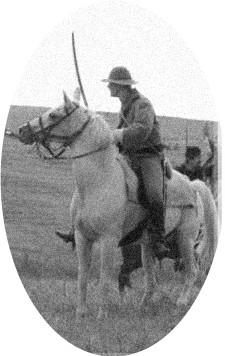Halfway down the trail to Hell, In a shady meadow green
Are the Souls of all dead troopers camped, Near a good old-time canteen.
And this eternal resting place Is known as Fiddlers' Green
Sir Charles

This wonderful animal was killed in a senseless fashion by a hunter who left a gate open and he was struck by a car. Charlie was Ms Mary's personal favorite. Born on my parents farm we owned his whole life, sixteen years. Before we started reenacting he had a distingushed career in the show ring, winning many ribbons and trophies. As a war horse he saw many battlefields, from Michigan to Mississippi, from Gettysburg to Tennesee.
Rudy Ayoroa The 9th,and the world lost a unique comrade He will be missed by all, his quick smile and kind words were always welcome in our camp. I can remember the first time our old comrade Roger Turpin brought him around. It was at Perryville many years back.He was wearing a resplended uniform, complete with horse hair plume. My first thought was "what the h,,, is that'. Boy, was I ever wrong. After some saber lessons I came to appreciate Rudy. He was a REAL cavalryman, a rarity these days. He always made a point to come by and speak to Mary, and sample her cooking, warning me I had better take care of her and treat her right or he would take her home with him. He did the cover art for the book Longest Raid of the Civil War, using several of our group as models, Roger Turpin the most prominant as Gen Morgan. His works hang in the Smithsonian, the Hirshhorn and the Museum of Modern Art of Latin America and in Danville, where he made his home. Born in LaPaz, Bolivia, he was a painter and a sculptor. He was at the forefront of the kinetic art movement in the mid-1950s. Geometric elements and contrasting warm and blue colors dominated his paintings and prints. In sculpture, he used Plexiglass bent into geometric shapes to reflect light and provoke a sense of perpetual motion, according to a flier for his 1980 exhibit at Centre College. The late art critic Marta Traba, who founded the Museum of Modern art in Bogot, said Ayoroa was "one of the truly great artists of his generation coming from Latin America." In the mid-1980s, he moved to Danville Kentucky with his former wife, Jane Ayoroa, who was born here. He said in a 1985 interview that adjusting to Danville was "the easiest thing that ever happened to me." While here, he developed an interest in painting Civil War battle scenes. He did a large number of paintings depicting the Battle of Perryville and was commissioned by Lebanon to sculpt Major General George H. Thomas. Local artist Wilma Brown said Ayoroa was the primary established painter in Danville and that his death is "a great loss to the arts here." She said he could capture the spirit of a person when he painted them. His paintings were "dynamic," she said. Ayoroa's work is displayed at the Hirshhorn Museum and Sculpture Garden; the Library of Congress; National Museum of American Art; Smithsonian Institute; Museum of Modern Art of Latin America at the Organization of American States, Museum of Modern Art in Bogota, Columbia and National Museum of Fine Arts in La Paz, Bolivia. He was educated at the University of Buenos Aires in Buenos Aires, Argentina. In 1964 he moved to Washington, D.C., and had been a visiting professor at American University. His last international one-man exhibition was in Taipei, Taiwan, in 1997. Born Sept. 16, 1927, he was the son of Esther Soria-Galvarro of LaPaz, Bolivia, and the late Gen. Robert Ayoroa. May the horses all be fast where you are old friend.

Jonathon Sears lost his little Mare, Fortune,to a Broken leg. This little horse changed my mind about mares in reenacting, and Arabs. Between her and Dave Baiocchi's Arab Mare, I have changed my perception.